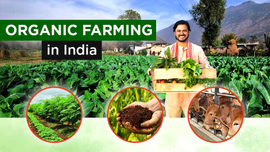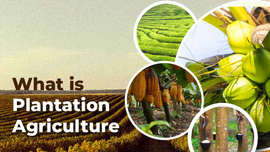How to Succeed in Rural Marketing: Insights, Trends & Key Strategies

The rural sector of India presents a huge opportunity for businesses that want to expand beyond the urban market. As more employment opportunities emerge and financial resources are increasing, rural consumers are also becoming increasingly brand conscious. However, marketing in the rural area requires a strategic approach as consumers in these areas are more diverse and scattered.
In this article, we will learn about rural marketing and its principles, its growing potential and challenges in India, as well as some of the most effective rural marketing strategies.
Table of Content
- Overview of Rural Marketing in India
- What is Rural Marketing?
- Difference between Rural and Urban Marketing?
- Potential of Rural Marketing in India
- Top Rural Marketing Strategies in India
- 4A’s of Rural Marketing
- Innovative Rural Marketing Strategies in India
- Evolving Landscape of Rural Markets – How Tractorkarvan is Driving Change?
- Rural Marketing in India – conclusion
Overview of Rural Marketing in India
Rural marketing in India plays an important role in making products & services accessible & affordable for the consumers from hinterland of India. It represents a huge and untapped opportunity for businesses across sectors, such as agriculture, FMCG and automobile industry to expand in rural areas. A mix of economic, demographic, and infrastructural factors has led to the increase in purchasing power, access and aspirations of rural consumers.
According to the Economic Survey 2022-23, in 2021, 65 per cent of the country’s population resides in the rural areas and 58.4% are employed in agriculture sector, representing the importance of rural India in the socio-economic fabric of the country.
What is Rural Marketing?
Rural marketing refers to the process of identifying, developing, pricing, promoting and distributing products and services specifically designed for the rural market. This type of marketing requires understanding the needs and requirements of a rural consumer, as well as ensuring the availability and accessibility of goods and services that can help improve one’s quality of life.
Rural marketing is classified into two segments:
Consumer goods market – This includes both durable goods (such as appliances and electronics) and non-durable goods (including foods and personal care products).
Agricultural Input Market – This includes the products required for farming, such as tractors and equipment’s, fertilizers, pesticides, seeds, and related supplies.
Difference Between Rural and Urban Marketing
Here are some of the key differences between rural marketing and urban marketing:
|
Aspect |
Rural Marketing |
Urban Marketing |
|
Target Audience |
Rural consumers from villages and small towns with traditional values. |
Urban consumers in metropolitan cities with modern, fast-paced lifestyles. |
|
Consumer Behaviour |
Value-sensitive, value-focused, faith-based shopping. |
Brand conscious and trend driven. |
|
Media Access |
Radio, television, local programs, social media and word of mouth. |
Extensive use of TV with OTT subscriptions, social media platforms, and digital or print media. |
|
Product Preference |
Affordable, durable, basic utility. |
Premium branded and lifestyle oriented. |
|
Payment modes |
Cash-based, less digital adoption. |
Higher use of digital payments, credit cards and UPI. |
Potential of Rural Marketing in India
Rural India holds massive marketing potential. According to a NITI Aayog report, Rural economy constitutes 46 per cent of national income. In 2025, per capita spending in rural areas rose by 9.2%, compared to 8.3% in urban areas. This growth highlights a sustained trend of consumption-led growth in rural markets, with a significant number of households reporting higher spending levels.
Large Consumer Base: Rural areas account for about two-thirds of India's population and generate nearly half of the country's income. Rural marketing allows businesses to expand their consumer base by targeting these areas, giving them access to a large but mostly neglected portion of the population.
Rising Disposable Income: Growth in rural employment schemes, agricultural productivity and non-farm income resources have increased purchasing power in villages.
Different consumption patterns: Socio-cultural factors such as traditions, values, and beliefs often influence the purchasing decisions of rural customers. Differences in customer behaviour and consumption patterns provide businesses with opportunities to increase their sales revenue by localizing products and marketing campaigns.
Untapped Market Segments: Many industries such as healthcare, e-commerce, education technology (Ed-Tech) remains un-penetrated, offering many opportunities to businesses.
Top Rural Marketing Strategies in India
Products, pricing, promotion, and distribution are the four most important elements of any form of traditional marketing, whether they are in urban or rural areas. These factors play an important role in determining the success of a marketing campaign.
Product Strategies
Effective Product Strategies for Rural Markets
Seasonal product launches: Rural consumers usually receive income as per their farm cycle. Therefore, to maximize the impact, companies must time their product launches to coincide with these seasons when purchasing power is at its peak.
Simple and memorable branding: In rural markets, brand identity often hinges on simplicity. Easy to pronounce names, distinctive logos, and recognizable product features like flavors and colors play an important role in building brand identity and trust.
Easy Access to Product: Given the limited disposable income of daily wage earners, products should be offered in small, budget-friendly packages. This approach makes products more accessible and encourages testing and repeat purchases among rural consumers.
Pricing Strategies
Effective Pricing Strategies for Rural Markets
Value-for-Money Focus: Sustainability and utility matter most to rural consumers. Pricing should reflect the long-term value of the product, reassuring buyers that they are making a worthwhile investment.
Festive and occasion-based offers: Festivals and local events are important in rural areas. Offering special discounts and promotional deals during these times can boost sales and strengthen brand loyalty.
Low price points: Affordability is key. The products should be priced within the reach of rural consumers, especially those with limited disposable income, to ensure accessibility and regular purchases.
Promotional Strategies
The following are some of the promotional strategies in rural marketing.
Mass Media: Villages have some entertainment options including television, radio, newspapers, and cinema. Companies can use these major media outlets to advertise their products.
Local Media: Local media includes audio-visual vans, animal parades, fairs, folk events, etc. Displaying advertisements, video clips, short films, posters and paintings at these places is also an effective promotional activity.
Distribution Strategies
Distribution strategies to reach rural consumers
Using local markets: Rural areas thrive on lively local markets such as weekly fairs, farmers' markets, and Sunday markets. These hubs provide excellent opportunities for brands to connect directly with consumers in a familiar setting.
Strategic company depots: Installation of company-owned warehouses and depots in key rural locations ensures timely product availability. These depots also serve nearby cities, increasing distribution efficiency and reducing delivery delays.
Empowering Local Retailers: Rural retail shops are the most accessible point of purchase for rural consumers. Brands must build strong relationships with these retailers and streamline supply chains to ensure consistent product availability.
Mobile Distribution Solutions: In areas with limited transport infrastructure, delivery vans, travel vendors, local traders, and even NGOs can play an important role. These mobile units deliver the products directly to the doorsteps of the consumers.
4A’s of Rural Marketing
Availability
One of the challenges to overcome when developing strategies for rural markets is getting the product available to consumers. For this reason, distribution channels are considered an important component for successful marketing in rural areas. The tractor industry has made significant strides in the rural market by setting up nationwide dealership networks. Popular tractor brands in India, such as Mahindra, Swaraj, John Deere, and Sonalika, have a strong rural presence, with their strong channel network in small towns and villages, ensuring better accessibility, service, and trust among farmers.
Affordability
Rural consumers look for value for money products & services. Therefore, it is important for marketing brands to make products that are economical and subsidized for those living in rural areas. Today, majority of banks & NBFCs have introduced various credit options for farmers which have made buying high-value products like tractors & other farm implements affordable. Farmers can get low interest & high funding rate tractor loan options with flexible EMI options. These financial solutions provide rural consumers with a new level of financial independence.
Acceptability
The product should be designed in a user-friendly manner such that it satisfies all the needs of a consumer by deriving them some value. One of the most important example of this is technological advancement in agricultural industry which has compelled businesses to create products that are in line with the needs of a modern consumer. In recent years, high-tech tractors have been introduced in the market. These tractors incorporate various features that make it suitable for different types of farming, from differential locks for improved traction, high precision hydraulics, to the narrowest track width available, specifically designed for use in orchards and vineyards.
Awareness
Product awareness is another key aspect of rural marketing through which consumers are familiarized with a product, service, or brand. It involves bridging the information gap between manufacturers and consumers by using targeted methods such as product demonstration, service camps, auto expos and village fairs (melas). The goal is to ensure that potential buyers get a complete walk-through of how the product works, why it is useful and how it can improve their lives. Tractor service camps in villages also offer free check-ups, maintenance tips and technical guidance, and further build trust with rural customers.
Innovative Rural Marketing Strategies in India
The rural market has gained momentum due to government interventions. Many industries in India have introduced marketing campaigns which have been successful in rural markets. Some of the examples include:
- In 2001 Hindustan Unilever started the project Shakti along with the Rural Self-Help Groups and make their brand reach every corner of the village. Women were chosen from village, trained by rural sales promoters and then sold products door to door and made ideally a profit margin of 10 percent.
- Philips corporation of Europe has successfully launched products such as Smokeless Chullah in the domestic product category; in the consumer electronics they developed the color television ‘Vardaan’ which was low priced for the rural consumers and operates on less voltage. They have also developed rechargeable lanterns and LED flashlights.
- The Sampoorna TV launched by LG Electronics was aimed at providing its customers with a good quality product at a price which was economic and reasonable.
Evolving Landscape of Rural Markets – How Tractorkarvan is Driving this Change?
As the rural landscape is undergoing a significant transformation, Tractorkarvan aims to be at the forefront of this change. By offering dependable insight into agricultural machinery—ranging from tractors to implements – Tractorkarvan ensures that these tools are more accessible to farmers across the country. The platform delivers detailed information on tractor financing options, up-to-date pricing, and model comparisons, informative tractor videos, among other resources. Through these efforts, Tractorkarvan aims to bridge the gap between technology and farming community.
Rural Marketing in India – Conclusion
Rural consumers differ fundamentally from their urban counterparts. Whether in terms of buying behaviour, cultural values or financial background. For this reason, a well-thought-out strategy is required for successful marketing in rural areas. Businesses should adopt marketing techniques and approaches that will allow them to capitalise on the vast rural potential. To succeed in the rural market, the approach, strategies, and marketing mix must be developed and evaluated through the lens of rural consumers.


Related Blogs












